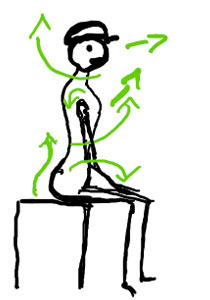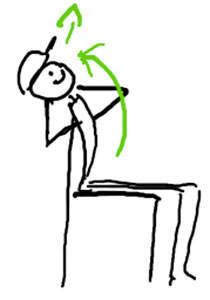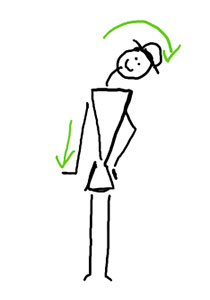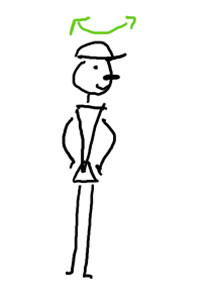
Back pain & Co
Remedies for the physical consequences of CoronaA topic that is not directly related to enjoyment, but which concerns us all. That's why we're giving it space here: Slouching at the computer at home only looks comfortable at first glance. Because bad posture in the home office usually makes itself painfully felt. YVONNE LACKINGER from the University Sports Institute Vienna shows with a few exercises how to make everyday sitting easier for yourself and your loved ones.
January 2021
Quick translation with DeepL
"Yes, that's about all the positions I take in a day," said the student daughter moaning. Many people in the workplace at home feel the same way as she does. Children as well as adults, an immoderate loafing with consequences for health and well-being. The advice of sports and posture expert Yvonne Lackinger is useful for all those whose backs hurt:
We all sit too much and mostly not on ergonomically shaped seating furniture. This makes itself felt. Functional targeted movements can dissolve long-lasting deviations (unhealthy habits) from conscious neutral joint positions of the body. At the same time, they promote well-being. The simple exercises listed here can do great things for your health. For the following movements, first make sure that you are sitting upright. While you are doing the exercises, your breathing should continue to flow calmly and evenly.
 |
Upright sitting posture. You can achieve this by sitting forward on the edge of the chair. You should now be able to feel your sit bones clearly. Your legs are hip-width apart and your feet are firmly on the floor. The big toes should be slightly rotated outwards.
|
 |
Exercise 1 is for stretching the spine.
Stay in this position a little longer and enjoy the stretch! Then return to a sitting position that is relaxed for you. |
 |
Exercise 2 is for straightening the body.
The aim is to support the upright posture. During forward circling the upper body is bent forward and rounded. When circling backwards, the "flexor chain", the front side of the body, is optimally stretched and extended. This is why backward circling is repeated more often than forward circling. Do the movement very slowly, then you will feel the pleasant straightening of the body. |
 |
Exercise 3 is for relaxing the neck and shoulder girdle.
Do exercise 3 very consciously and pay attention to feedback from your body. Where and when do you feel a counter-tension in your muscles? These exercises focus on stretching the neck muscles. Tension in the shoulder and neck area is released and gently mobilised. |
Note that the exercises need regularity to be effective. The longer the body has been in its monotonous posture, the more noticeable the change will become. These changes can also have an after-effect. This means that for a long time after completing an exercise, you may notice a pleasant feeling. If you have pain, give the body two to three more repetitions to adjust. If the pain changes positively (pain goes away), then you can continue exercising with peace of mind. However, if the pain remains, you should skip the exercise. Practice mindfully and without haste.
 |
If you have any questions about the exercises or about individual or group gymnastics sessions, you are very welcome to contact me - here in an upright position 😉: yvonne.lackinger@univie.ac.at My expertise: Lecturer at the University Sports Institute Vienna, ergonomics trainer, guest lecturer at the Vienna University of Teacher Education, lecturer at BWL-Bewegtes lernen Vienna, child-friendly ergonomics in everyday school life. Image source: Yvonne Lackinger |




